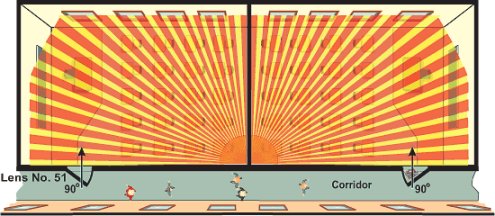3B. Classrooms/conference rooms with passive IR detector
Two classrooms and ventilation control
| Premises
In classrooms (or conference rooms), incorrect skills should not be passed on. Pupils should not learn that lighting is automatically switched on and off, but should instead be taught to switch on as necessary (the classroom gets natural light through the windows) and to switch off after themselves. It must also be possible to switch the lighting off when watching films etc. Light sources The fittings can have conventional 50 Hz operating devices, non-dimmable or dimmable HF operating devices. In the latter case the lighting can be dimmed manually using a separate potentiometer that does not affect the presence control. Positioning of detector The positioning of the detector is crucial to the function! The illustration below shows how the detector should be positioned. Combined with Lens 51, which permits higher positioning, optimum detection during entry is achieved. In addition, the detector cannot see out through the doors, which means that lighting is not left on due to people passing in the corridor outside. Positioning of the detector in the corner farthest away from the door means the detector can be mounted higher up, thus reducing the risk of damage. With this mounting the slightly downward-pointing fields reach down at a suitable height over by the door. |
Control system
To access the concealed savings potential available in all areas with daylight, the installation should be provided with activation/deactivation logic that prevents the light being activated upon entry. It is maybe not all activities that require extra light in addition to natural light, and personal need must govern when it is switched on. This means lighting is switched on and off in the normal way using an impulse push-button. Lighting is turned off by detector after set time (3 – 5 minutes) only when no one remembers to switch lights off. The EX-13 logic module is suitable for up to four lighting groups, or as shown here, two rooms with two lighting groups in each, plus ventilation control. The output for ventilation control has an adjustable operational delay (0 – 1 hrs) to prevent the ventilation starting in the event of brief use of the premises. The ventilation output also has an adjustable switch-off delay 0 – 2 hrs that starts when the presence ceases to ensure proper outgoing ventilation. The ventilation can also be started manually, but not switched off manually. A fire alarm can also be connected to the EX-13. In the event of a fire alarm the fans are stopped and the lighting is switched on. Classrooms are not frequently used areas, as the operating times are relatively long, thus Dynamic Lighting control is not needed. However, a system with Logic Module EX-22 for constant lighting combined with logic for presence control can be used. For smaller installations with only 1 – 2 lighting groups, the EX-11 logic module is used. |
||||||||||
 |
|||||||||||
 |
 |
||||||||||
 |
|||||||||||
|
|||||||||||
|
|||||||||||
| Hidden savings potential in classroom
Classes on a day in November: This illustration shows an installation with two lighting levels. |
|||||||||||
 |
|||||||||||





